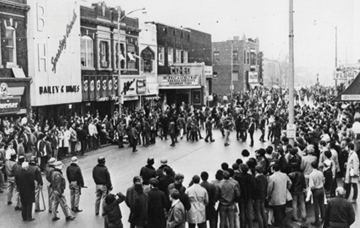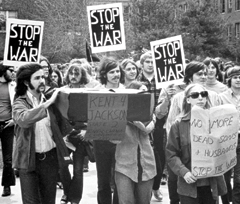Lincoln Hall Project
Illinois at the Crossroads
A Time to Protest

(Photos courtesy of University Archives)
Days of Protest
Student activism of the era had many roots, from prices at the local drugstore all the way to President Richard Nixon’s decision to invade Cambodia. One particularly large protest in March 1970 stemmed from student grievances surrounding a new supercomputer on campus, Illiac IV, which would devote programming to the U.S. Department of Defense. At the same time, General Electric—a magnet for protesters—was recruiting on campus, and the Board of Trustees canceled a speech by the self-described “radical lawyer” William Kunstler. Windows were smashed, buildings were stoned, and someone planted firebombs in Altgeld Hall. Authorities summoned more than 1,000 National Guard troops and state police officers to campus, where they enforced a curfew and made more than 200 arrests. Illiac IV was eventually removed from campus and Kunstler was eventually allowed to speak.
Divisions between Students and Parents
Student protesters faced heavy criticism from parents and others who had come of age during World War II. When one group of U of I students sent a letter to their hometown newspaper calling for a nationwide strike following the Kent State University shootings in 1970, many readers responded, with one from a “worried mother,” reading: “If the Japanese had been a little more clever, they could have overrun our country in a short time, and you students wouldn’t be around to write your protest letters, or if you would be, you’d be under a government that wouldn’t allow it.... If those four students would have been in their classrooms no one would have been killed.”

A Conflicted Response to Protest
University administrators were clearly conflicted on some student grievances. They created a “free speech” zone on the Quad, and they created committees on preserving the University’s academic mission while following laws against “subversive” speech.” Public meetings and debates arose often between students and administrators, and the Office of the Dean of Students created a thick file of articles trying to understand the students’ point of view. One heavily marked report by Jerome Skolnick for the National Commission on the Cause and Prevention of Violence read, “If any generalizations can be made, it would be that student movements arise in periods of transition, when, for example, the values inculcated in children are sharply incompatible with the values they later need for effective participation in the larger society.”
By Dave Evensen